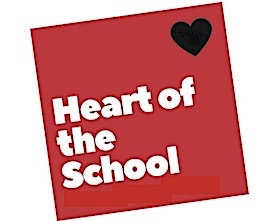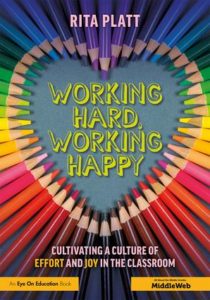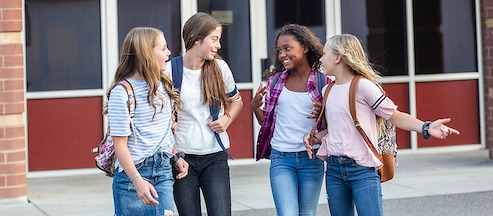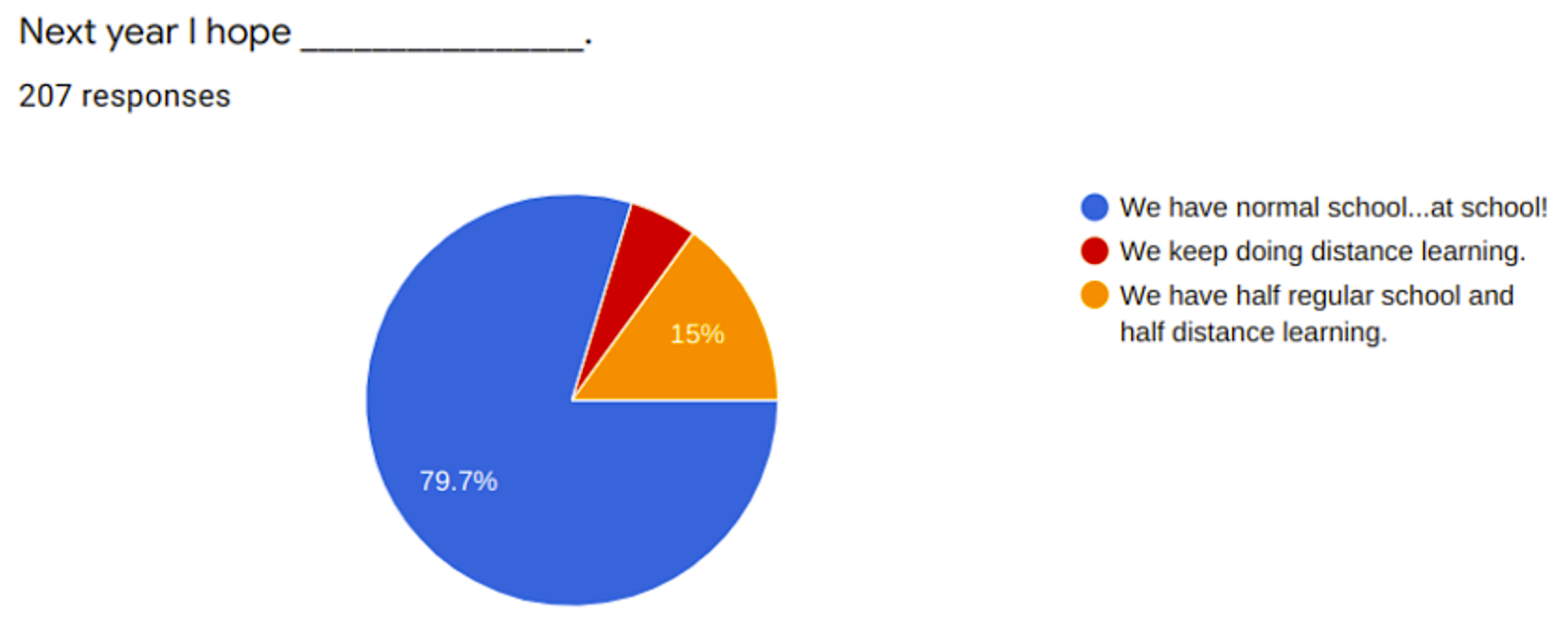Survey: What Kids Said about Remote Learning
A MiddleWeb Blog

When I shared that post with the teachers in my school district, one of them wondered how the students’ experiences aligned with those of educators.
After I kicked myself for not thinking of that myself, I wrote a survey seeking information from students in our schools. More than 200 students in grades five through eight responded.
What Our School Did
Before I get into the student responses, I want to share how our Middle School (grades 5-8) handled remote teaching. The middle school was ready to start full-time distance education within three days of the closure. Every student was provided with a Chromebook and those who needed them, also got hotspots to hook up to the internet.
We are a far-flung rural Wisconsin community and the internet is spotty in many homes throughout the district. All teachers delivered content to students through email or Schoology by 8:00 every morning. Most made videos or included very specific instructions.
While I am the principal at the elementary school that feeds the middle school, not of the middle school itself, I not only have close contact with the principal and teachers there – two of my own children attend it. (I’ve also been a middle school teacher.)
In addition to the information provided by the students, I have some insight into how remote learning went from professional and parental lenses. I was impressed with how well it all came together. That said, distance learning, no matter how well done, is a huge challenge.
The Survey
To kick-start student thinking, I asked them to rank how well they liked distance learning on a scale of one to ten. The results are below.
- 20% chose from seven to ten, meaning they liked it better or much better than “regular” school.
- 32% chose from four to six, or about the same as “regular” school.
- 48% chose from one to three, which means they liked learning from home less or much less than “regular” school.
The bulk of the survey was comprised of three questions.
- What is the hardest part of learning at home during the COVID crisis?
- What were the good things about distance learning?
- What are your worries about how school might go next year?
I was impressed by the reflections students shared with me and found their thoughts helpful. I hope you do too. Keep in mind, this is a small sample size which consists exclusively of students in my rural Wisconsin school district, and I am a mediocre survey-writer at best. All of that aside, there is wisdom and value in what they wrote.
Below you will find both direct quotes from survey participants (in italics) and my summarizing comments.
1. What is the hardest part of learning at home during the COVID crisis?
Students in my survey noted four main “hard parts” of learning at home. One, they miss the direct instruction and help teachers can provide them in a face-to-face environment. Two, they feel learning at home is a challenge due to many distractions. Three, students noted having trouble with technology. Last, and perhaps the saddest frequently noted hard part, was that middle grade students really miss their friends.
I think the hardest part about at-home learning is having to wait a little while before getting a question answered. I can’t talk to my teachers!
The comment above was often repeated. The students really missed the opportunity to check in with teachers, ask questions, and get feedback from them. Even though there were regular office hours and students were encouraged to pop on Zoom or email questions, it didn’t feel the same to most of them. They wanted immediate support, and who can blame them? That’s how they have learned to navigate school life.
I think that learning at home can be really difficult because there are so many distractions. I always get off track and start doing something else.
From “annoying brothers” to video games to playing outside, students shared that it was really hard to stick to their work and a semblance of a routine because at home there are some many legitimate competitions for their attention. They also talked about how they found their motivation to sit in front of a computer and complete work was “emotionally draining” and hard to maintain. I think that many adults can understand that, especially teachers who found themselves working at home.
Glitchy tech sucks!
Tech is a serious concern in education in the COVID Era. Despite our best efforts, we could not make the technology work for all in a truly equitable way. Students commented on slow internet speed, being confused by multiple platforms, and having trouble submitting assignments online.
Additionally, there were many comments that shared the notion that technology is not the ideal way to learn. Students said that Zoom meetings were good and they appreciated the videos the teachers made, but it “just isn’t the same.”
What I miss the most about real school is getting to see all of my friends because I have not seen some of them in over 2 months.
One of the most common comments had to do with the loss of social connections. Despite the fact that they remained in digital contact with friends, students missed just being with other kids their age. Working in peer groups, eating lunch in the busy lunchroom, crowded hallways at passing times, and before and after school activities were all frequently shared as opportunities students longed for.
2. What were the good things about distance learning?
There were fewer categories of good things noted by the respondents. Those that were shared largely fit into one of two categories: One, a more fluid schedule with more time for leisure activities; and two, a sense that they were doing their part to keep others safe from getting COVID 19.
The good thing about staying home is that my schoolwork only takes 2 hours. Then, I have pretty much all day to do whatever I want!
Students loved being able to sleep in! Many shared feeling less tired and more energetic. Several noted a total shift in schedule, sleeping much later but staying up much later too.
They liked having some control over their schedule. Many shared that they liked working for an hour or two, taking a nice long break, and then getting back to work when they felt ready. Others talked about getting right to work, finishing their assignments quickly, and having the rest of the day to spend however they chose.
Additionally, there was frequent mention of appreciating more time to spend with their families and for enjoying the outdoors and being able to de-stress.
The good thing about staying home is that we aren’t putting anyone in harm’s way.
Surprisingly, there were not a great deal of comments related to being scared of getting the COVID-19 virus. There were several references to the idea of feeling happy to be a part of keeping society safer.
3. What are your worries about how school might go next year?
Not surprisingly, the students’ worries mirror those of most educators I have spoken to. They are concerned that school will not return to normal, that they won’t be prepared for the next grade, and that they missed what could have been some of the best days of their lives.
Will we go to school ever again?
I am sure that it doesn’t come as a surprise to anyone that students are concerned about a return to life as they knew it before COVID-19. They wonder what school will look like this fall. They want to be in their classes with their peers and their teachers but wonder if they’ll have to wear masks and what will happen if they get sick.
I worry about how much learning we missed. Most of the teachers are giving easier work than they usually would.
About half of the respondents shared a concern that they would be behind where they “should” be. There were comments about not being prepared well enough for the next grade and fears about being “held back.”
This was a concern that I found to be particularly interesting because it was not one that was widely shared by the teachers from my last survey. The stress connected to the fear of being help back or not ready these students must feel breaks my heart.
I could have made so many more memories with my friends…will I be able to have fun next year?
The last common thread among the student responses is the sadness many feel at having lost the last trimester of a school year they will never have again. They lament missing assemblies, field trips, and class parties. They feel sad about lost sports seasons and school clubs. They wonder what fun they might have had if only they could have finished the year as usual, and they worry they won’t ever be able to do those things again.
Lessons Learned for Moving Forward
This whole COVID closure experience has been a bumpy road for all of us. But honestly, what feels even more daunting is preparing for the future. When the closures happened, we had to react and do it quickly. Now, with so many changing expectations and recommendations, the constant barrage of information and misinformation, and the chore of balancing what we wish we could do with what is really possible, the road ahead seems nearly impassable.
In the last question on the survey, I asked students to share their hopes for the format school takes in the fall. The vast majority want a return to the usual. They want to wake up in the morning and go to the school building and attend classes all day. Most educators and parents I know want that too.
Click to enlarge
As I write this, the recommendations throughout the nation are to prepare for a number of possibilities, only one of which is “regular school.” With that in mind, below are my three major takeaways from the student responses to the survey.
1. Students need to be prepared to learn at home.
Helping students with study skills, including finding a quiet place to work and setting up home routines, is needed. The number of students who made comments about the lack of structure and tendencies to be distracted made that abundantly clear.
Additionally, teachers having and sharing clear office hours when they are available by phone, email, or video conferencing is important to empowering students to ask questions when they need to. Our school thought we did a good job of that, but in reading student comments, perhaps we can do better next time (if there is a next time….oh how I hope there isn’t a next time…)
Last, offering a consistency in platforms for content delivery would be helpful. So would intentional and explicit instruction on how to use them to access assignments, turn in work, and communicate with the teacher. Even if we think kids already know how to use Schoology or Google Classroom or Flipgrid or whatever, we need to take the time to show them how it will be used in each class.
2. When it comes to remote learning, less is more.
Teaching online is simply not the same as teaching in a real classroom. If we want our students to get the most out of distance learning, then we have to really drill down to what is the most important for them to learn.
Many districts, including my own, has been working on identifying “Essential Standards” for years. These are the standards in each content area that are deemed must-teach for success. But, honestly, when we looked at our Essential Standards, we realized that in the face of distance learning, they were still too much.
Teachers worked to pare them down to the three to five most essential learnings in each content area. One of the teachers on my staff calls them the “Ride or Die Standards.” I love that!
3. Social-emotional support is really important.
Above you read about the concerns of the students in my district. Many of them are feeling acute anxiety and a sense of isolation that is heart-breaking. Assuaging some worries is going to be important moving forward.
That starts with being open and honest with kids about what school might look like next year. It continues with telling them explicitly that they will not be held back or otherwise have to re-do last year. In fact, in my survey of teachers NONE of them commented on a serious worry that there will be a huge learning gap.
Next year we will need to work on keeping connections strong no matter what form school takes. This means connections between teachers and students, teachers and families, and students and other students.
As always, I would love to make this a conversation. Does what our students said resonate with what you’re hearing or your thoughts on your own students? What next steps do you see? Feel free to share in the comments.











































